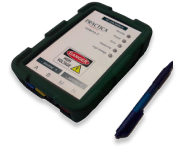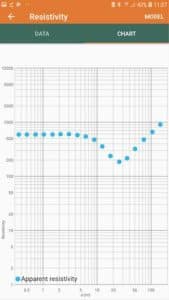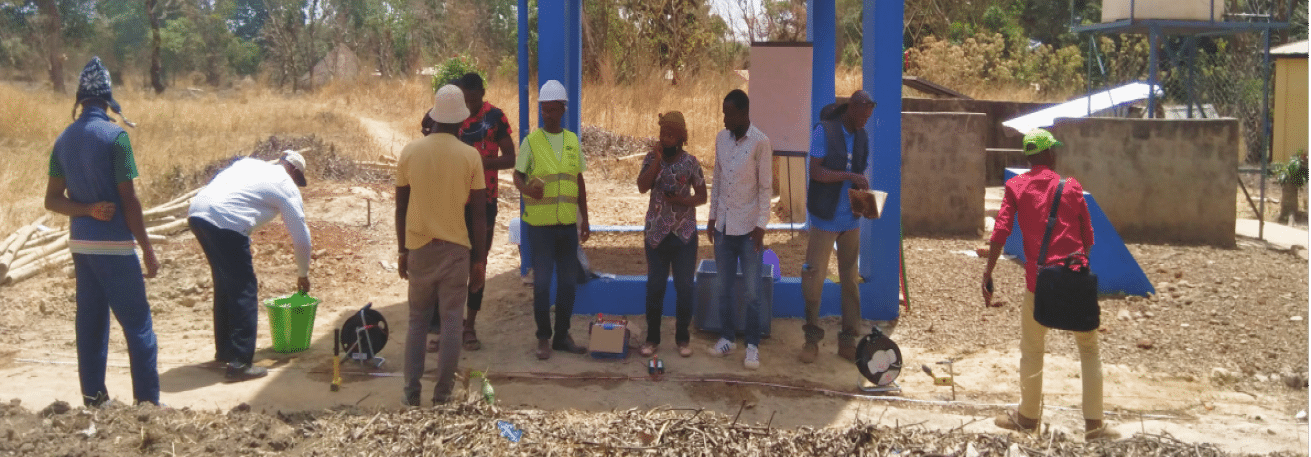Volterra device
A low cost, high success borehole siting device
Geophysical siting is an important part of water point construction. It prevents money and labor being wasted into drilling failed boreholes. While traditional VES equipment supports siting at a limited scale, it is too expensive and sparsely available in the global rural South. Practica therefore developed the Volterra, a device which is ~8 times cheaper than traditional equipment, but with the same borehole success rate. We can deliver it including a resistivity siting kit and Practica’s Drillers Toolbox: an app and web-dashboard for data collection and analysis.


Our innovation
Drilling new water points is often complex and costly. NGOs and drilling companies in the global South often struggle to select the right sites. Randomly drilling is therefore common, often resulting in dry boreholes due to hard rock formations. Drilling companies need to bear that risk themselves, which increases the costs of borehole construction.
Selecting the most promising areas with help of siting devices increases the efficiency of water programs, since it provides information on the preferred drilling method, the likely cost, the expected drilling depth and potential rock formations. Traditional Vertical Electrical Sounding (VES) equipment for siting is expensive (€10.000 - 30.000) and is sparsely available in the global South. The equipment has hardly changed in the last 50 years, with paper record keeping and computer analyses still part of today’s VES measurements. Together with the high level of required skills, these are barriers for a larger group of users who could benefit from VES.
To reduce complexity and costs, Practica has developed The Volterra, a portable VES/HEP device operated with a smartphone which is easy-to-use, ~8 times cheaper than conventional VES equipment while giving identical results, and it provides data accessible in a digital and shareable format.
This revolutionary device in combination with a resistivity siting kit and Practica’s Drillers Toolbox brings geophysics into the reach of a much broader audience such as local drillers and NGOs in the development and humanitarian sectors. With data interpretation by geohydrologists, rapid assessments with the Volterra can become a significant cost and time saver.
Our design
The Volterra measures ground resistance and can perform Vertical Electrical Soundings (VES) or Horizontal Electrical Profiling (HEP). The 10 watt, 600 Volts device is controlled through a smartphone app via Bluetooth. A complete measurement can be defined including method (Wenner or Schlumberger) and an array of electrode spacings. The portable size makes it easy to carry to the field or on the plane. Data capture (raw and calculated) is made visual in a graph and together with smart measuring, the device helps to minimize errors. After submission of data, the user receives an email with a pdf report and excel file, which includes both the raw data and modeling results.
The Volterra can be plugged onto your own resistivity siting kit or one provided by Practica, which includes four stainless steel electrodes, measurement cables, tapes, hammers, gloves, and all other items needed. Using Practica’s Drillers’ Toolbox smartphone application, which has a module for capturing and displaying resistivity data, will lead to better quality data. Because the data is immediately visible in the field, quality issues can be identified straight away and corrected.
Our ambition
Our ambition is that all local drillers and NGOs supporting water programs in the global South can benefit from the ease of operation and low cost of the Volterra, and generate quality groundwater data which will benefit the sector as a whole. The Volterra has been validated through lithology (rock formation testing) and depth proofing in Mauretania, Mali, Chad, Mozambique, Madagascar and Liberia. It has been applied successfully in other countries, like Guinea and Zambia.
Will you be our next partner in application or scaling? Practica can supply complete siting kits, including physical equipment, digital applications and instruction videos. Moreover, it can support with in-country staff capacity building programs and provide consultancy services to manage your groundwater development programs better.

View or download this brochure in PDF
Interested by the Volterra?
Did you know that Practica also sells full resistivity siting kits that can be used with the Volterra, and that you can systematically log and visualise all your drilling data with our Drillers Toolbox?
For more information on our impact, read our page on groundwater development.
